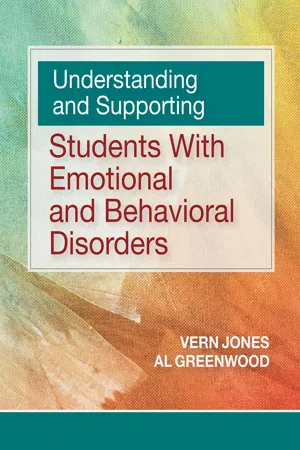
Understanding and Supporting Students with Emotional and Behavioral Disorders
- 444 pages
- English
- ePUB (mobile friendly)
- Available on iOS & Android
Understanding and Supporting Students with Emotional and Behavioral Disorders
About this book
Students who experience serious emotional and/or behavioral disorders (EBD) are at risk for a wide range of negative outcomes, from limited academic progress to problems with employment and community life after they leave school. Positive educational experiences can help, and this textbook fully prepares educators, school psychologists, and administrators to create supportive K–12 learning environments that help students with EBD thrive.
This comprehensive text gives professionals a deep understanding of the key issues associated with EBD and practical, trauma-informed approaches for working with these students in a variety of settings, from general education classrooms to specialized intervention programs. Readers will discover how to:
- Recognize key factors that influence each student's behavior, such as developmental history, personal characteristics, skill sets, and social perceptions
- Help students develop positive, supportive personal relationships with adults and peers in the classroom
- Deliver meaningful, engaging instruction within safe and supportive learning environments
- Involve students in creating behavioral standards that support engagement in instruction
- Develop effective behavior support plans that include assessment and intervention
- Respond with proven strategies when students fail to follow established behavior standards
- Engage students in problem solving and conflict resolution
- Implement social–emotional learning strategies that help break down obstacles to school success
- Develop and assess a program that provides specialized support in a more contained setting for students with more intensive needs
- Create a plan for staff development and support of staff working in programs for students with EBD
Special features throughout the book—such as chapter outcomes, summaries, reflection activities, forms, sample lessons, checklists, and case studies—ensure comprehension and help readers successfully implement the concepts and methods. Also included is a complete package of online companion materials for faculty, featuring PowerPoint slides, a test bank, and sample syllabi.
An essential textbook and an important inservice professional resource, this book gives readers the knowledge and skills they need to support students with EBD and help them succeed in school and in life.
Frequently asked questions
- Essential is ideal for learners and professionals who enjoy exploring a wide range of subjects. Access the Essential Library with 800,000+ trusted titles and best-sellers across business, personal growth, and the humanities. Includes unlimited reading time and Standard Read Aloud voice.
- Complete: Perfect for advanced learners and researchers needing full, unrestricted access. Unlock 1.4M+ books across hundreds of subjects, including academic and specialized titles. The Complete Plan also includes advanced features like Premium Read Aloud and Research Assistant.
Please note we cannot support devices running on iOS 13 and Android 7 or earlier. Learn more about using the app.
Information
1 | |
Key Concepts and Assumptions Related to Effective Support for Students With Emotional and Behavioral Disorders |
CHAPTER 1 OUTCOMES
At the end of this chapter, the reader will be able to:
- Outline the current state of affairs in supporting students with emotional and behavioral disorders (EBD).
- Understand the key factors influencing an educator’s ability to support students with EBD in becoming successful learners.
- Describe the key assumptions that support effective school-based supports for students with EBD.
SERVICES AND LEVELS OF SUCCESS FOR STUDENTS WITH EBD
Table of contents
- Cover
- Title Page
- Copyright
- Contents
- About the Authors
- Preface
- Acknowledgments
- Dedication
- Chapter 1 Key Concepts and Assumptions Related to Effective Support for Students With Emotional and Behavioral Disorders
- Chapter 2 Developing a Foundational Understanding of Emotional and Behavioral Disorders
- Chapter 3 Developing Relationships That Support Students With EBD
- Chapter 4 Developing Behavior Standards and Increasing Students’ Motivation to Learn
- Chapter 5 Responding Effectively to Disruptive Behavior
- Appendix
- Chapter 6 Developing Individualized Behavior Support Plans: Planning for Student Success
- Chapter 7 Social–Emotional Learning Methods for Supporting Student Success
- Chapter 8 Developing an Effective Program for Students Identified as EBD
- Index
- Back Cover